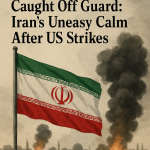As June 2025 unfurled its summer blossoms, it also bore witness to a geopolitical storm brewing in the Middle East. The United States, under the helm of President Donald Trump, unleashed a winged rain of firepower on Iran’s primordial nuclear establishments, bringing about expansive damage to their nuclear competences. The backdrop? An explosive concoction of escalating disagreements between Iran, the United States, and Israel. This irrevocable act, now etched in the second decade of this century’s history, petered across the global political landscape, preluding Iran’s wrathful intentions to retaliate.A proverbial powerful pun, Iran positioned itself to potentially shut down the Strait of Hormuz, a stratagem that would surely put global oil shipping and prices precariously out on a limb. This chess move resulted in reactions that wove their way through international corridors – lawmakers around the world hoisted debates about the legality of the airstrikes, and the ominous shadow they cast over a potential protraction of the Middle East conflict. Additionally, the power corridors within the U.S. were rocked, as Congress grappled with concerns pertaining to President Trump’s authority to make such a unilateral move without explicit blessing.In the ensuing aftermath of the airstrikes, a tense murmur has snaked its way around the globe, as the international fraternity attentively observes Iran’s subsequent manoeuvres and the corresponding diplomatic riposte. As the sands continue to shift within this evolving geopolitical saga, one thing stays absolute – only time will reveal what this act has truly paved the path for.







